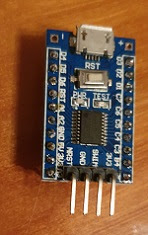Tested my QYF TM1638 module with Arduino Uno
After some experimenting with my QYF-TM1628 board i got the example found at http://www.getmicros.net/arduino-qyf-tm1638-module-example.php
and arduino library at https://github.com/rjbatista/tm1638-library working.
First i tried without success another example found somewhere else on the internet. After further searching i found the example mentioned above. I had some doubt as the text in the wiring picture contained an error (two times GND at the Pinout text in the picture). I followed the wiring as displayed in the picture and the code, So my wiring was
- Gnd – GND from Arduino
- DIO – data pin, another ouput from your Arduino (Pin 8)
- CLK – clock pin, an output from your Arduino (Pin 9)
- STB – strobe pin, an output from your Arduino (Pin 10)
- VCC – 5v from Arduino (5V)
The Dupont wire provided with the module was Female-Female, so i replaced it with female-male to connect it with an Arduino Uno.
Example code:
#include <TM1638.h>
#include <TM1638QYF.h>
TM1638QYF module(8,9,10);
word mode;
unsigned long startTime;
void setup() {
startTime = millis();
module.setupDisplay(true, 7);
mode = 0;
}
void update(TM1638QYF* module, word* mode) {
word buttons = module->getButtons();
unsigned long runningSecs = (millis() - startTime) / 1000;
// button pressed - change mode
if (buttons != 0) {
*mode = buttons >> 1;
if (*mode < 128) {
module->clearDisplay();
delay(100);
}
}
switch (*mode) {
case 0:
module->setDisplayToDecNumber(runningSecs, 1 << 6);
break;
case 1:
module->setDisplayToDecNumber(runningSecs, 1 << 5, false);
break;
case 2:
module->setDisplayToHexNumber(runningSecs, 1 << 4);
break;
case 4:
module->setDisplayToHexNumber(runningSecs, 1 << 3, false);
break;
case 8:
module->setDisplayToBinNumber(runningSecs, 1 << 2);
break;
case 16:
char s[9];
sprintf(s, "Secs %03d", runningSecs % 999);
module->setDisplayToString(s, 1 << 1);
break;
case 32:
if (runningSecs % 2 == 0) {
module->setDisplayToString("TM1638QY", 1);
} else {
module->setDisplayToString(String("LIBRARY "), 1);
}
break;
case 64:
module->setDisplayToError();
break;
case 128:
module->setDisplayToDecNumber(*mode, 0);
break;
case 256:
module->setDisplayToString("ABCDE", 1 << (runningSecs % 8));
break;
default:
module->setDisplayToBinNumber(buttons & 0xF, buttons >> 8);
}
}






















